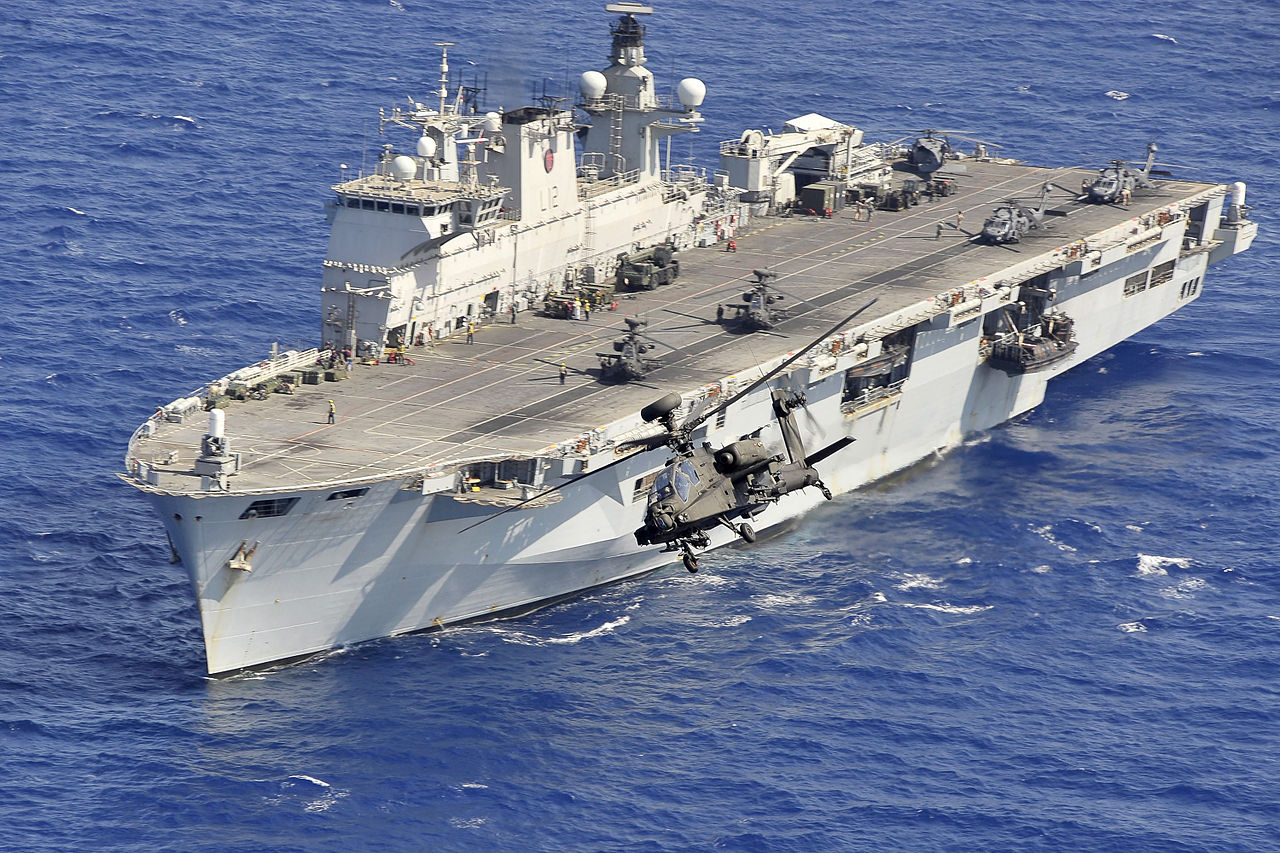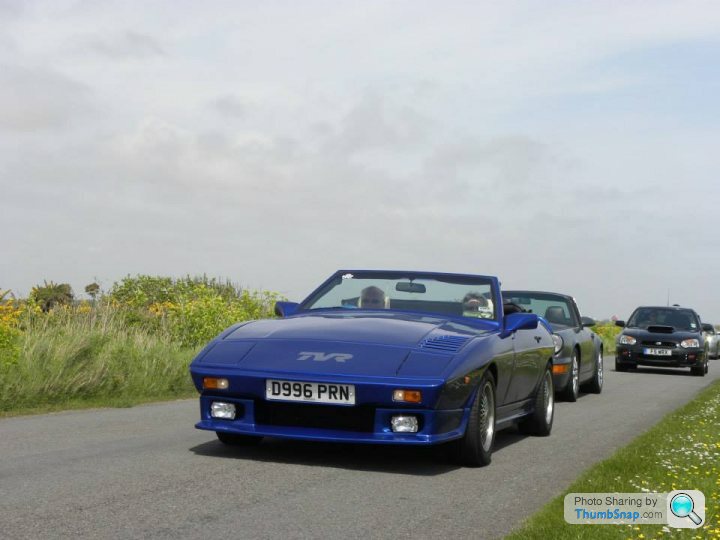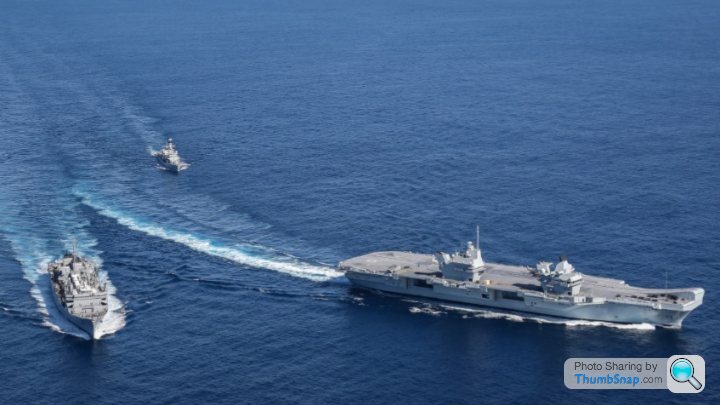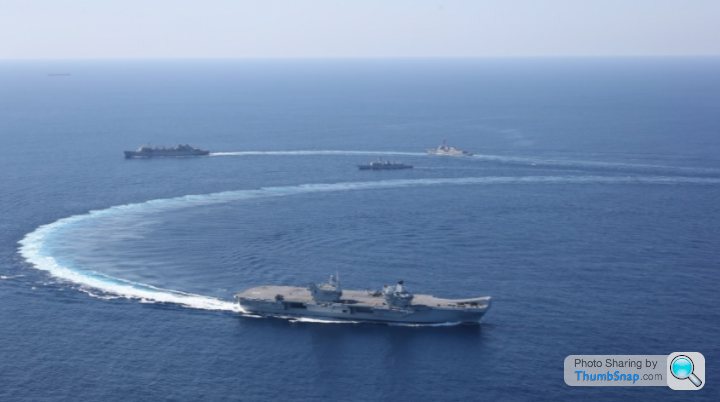HMS Queen Elizabeth
Discussion
RizzoTheRat said:
saaby93 said:
Whats under that sloping bit at the left end?
Do they have to store something that was too tall for the original design
Its where they store the catapult and arrestor gear that they didn't get round to fittingDo they have to store something that was too tall for the original design
thewarlock said:
Talksteer said:
HMS Ocean famously was built this way and cost no more the buy than a Frigate despite being 20,000 tonnes. So lots of small aggressive platforms and lots of big dumb ships more like armed RFAs.
HMS Ocean, built to commercial standards, is often used as an example of how not to design and build a naval vessel though. It was a bad idea at the time, and it's still one now, which is why it doesn't happen any more.thewarlock said:
RizzoTheRat said:
Meanwhile the Type 31 is based on the Iver Huidfeld, which is built to commercial standards. Is the Type 31 intended to be the same?
No, the T31 is based on the Iver Huitfelt, but is being assessed to Lloyd's Naval Ship Rules, same as T26, T45, QEC, OPV, etc.Also I'm pretty sure IH was designed to DNV Naval rules.
RizzoTheRat said:
I'm pretty sure elements of it were designed to commercial DNV rules, with a lot of COTS stuff used, particularly in the IT systems, but I'm sure I've heard something about them being considered a bit fragile compared to other nations frigates. On the other hand they're designed to be very flexible with "plug and play" modules they can drop in and out.
Ah. I only deal with the big grey metal parts, I have no idea about their IT systems, but the UK T31 is being designed to LR NSR.thewarlock said:
Ah. I only deal with the big grey metal parts, I have no idea about their IT systems, but the UK T31 is being designed to LR NSR.
Yeah, a but of googling suggests IH's are built to DNV naval standards, so maybe the point is they used a lot of commercials standards as well for things like systems interoperability, to enable the modular design. Presumably that, and the use of COTS kit, keeps the build cost down and simplifies refits, but means some internal systems aren't as robust as traditional ships.98elise said:
If you could hit a ship with a hypersonic missile then you wouldn't even need a warhead. The kinetic energy would be enough to destroy it, especially on a balistic trajectory.
You dont need a warhead even with stereotypical antiship missiles. We learnt that with the Falklands. Let alone a high speed high kinetic energy missile. Although CIWS and anti-ship missile defence has improved a lot, it is still vulnerable in many areas. Eg we still rely on phalanx and IMO it just doesn't have the engagement range to take out the missile and the boosters and large shrapnel before it hits the ship. We don't currently have a seawolf replacement with that kind of capability against such weapons. With a modern "lean" manned ship with relatively complex and fragile systems, heavy and large shrapnel coming inbound may not sink the ship but if your main weapons and sensors are down then you have no operational capability and are basically just a cruise ship. 98elise said:
Exactly. I was exchanged with the Kuwaiti navy in the gulf and the Captain on the s tty corvette i was on was surprised how much we threw our ships around. He was also surprised how quick a T42 destroyer was off the line when the two Olympus gas turbines kicked in. Although I think he was the Captain because he was some kind of royal or something, certainly not because of his naval tactics. He thought the best way to engage a modern warship was to go in with the 76mm Oto melara gun rather than stand off and use the exocets. They were proper cowboys, did some gunnery training and they couldn't hit the "killer tomato" enough to sink it so ran it over instead then had sailors hanging over the bow shooting it.
tty corvette i was on was surprised how much we threw our ships around. He was also surprised how quick a T42 destroyer was off the line when the two Olympus gas turbines kicked in. Although I think he was the Captain because he was some kind of royal or something, certainly not because of his naval tactics. He thought the best way to engage a modern warship was to go in with the 76mm Oto melara gun rather than stand off and use the exocets. They were proper cowboys, did some gunnery training and they couldn't hit the "killer tomato" enough to sink it so ran it over instead then had sailors hanging over the bow shooting it. Psycho Warren said:
98elise said:
Although CIWS and anti-ship missile defence has improved a lot, it is still vulnerable in many areas. Eg we still rely on phalanx and IMO it just doesn't have the engagement range to take out the missile and the boosters and large shrapnel before it hits the ship. We don't currently have a seawolf replacement with that kind of capability against such weapons.
Have they not upgraded the Type 23's to Sea Ceptor yet? Quite a few countries seem to be picking it over ESSM these days so it's presumably pretty effective (or possibly very cheap).RizzoTheRat said:
Have they not upgraded the Type 23's to Sea Ceptor yet? Quite a few countries seem to be picking it over ESSM these days so it's presumably pretty effective (or possibly very cheap).
Think its in progress on the last few in refit so should hopefully be fully operational and plug the gap. I do wonder if the aster 15 on the T45's would eventually be replaced with the Sea Ceptor for commonality and it being slightly newer and more capable? all the key parts of the PAAMS system are retained so should be a relatively easy swap. What annoys me is how the budget cuts have really effected the fleet. Eg the additional 16 cells, "fitted for but not with". The current set up and mix of missiles could leave the ship vulnerable in a prolonged engagement. Will probably be fine in one saturation attack with the designed stock levels (bear in mind they carry a mix of missile types) but a second could be ropey and you don't really want to have to pull out the front line to re-arm when we've only got so few of the ships and the current models often see them operating alone or in very small task groups. Its certainly a weakness.
But then the whole T45 project was a catalogue of budget cut nightmares. Ranging from hull numbers, capability cuts etc. eg the only reason the samson radar has only two phased array panels and hence needs to rotate was budgetry considerations. The rotating array mechanism is a major battle damage weak point that having 3 or better still 4 fixed panels (like most other phased array systems) would have solved. The survivability of a 4 panel system is much much better in terms of retained capability under damage/fault conditions.
Sure for a limited engagement situation against a weak opposition, fine, you will likely get away with it as close range incoming threats are not likely to be an issue if we keep them in thier design environment out to sea providing area air superiority. However budget cuts to amphibous and littoral capabilities mean often these ships are now operating closer to shore than the design intent.
I've been a civvy
 now for almost 13 years and the cuts in service for me were massively noticable and since i have left, the navy seems decimated. Lets hope the sacrifices to ensure we got the 2 carriers were worth it in losses elsewhere. Although thats a massive debate in its own right!
now for almost 13 years and the cuts in service for me were massively noticable and since i have left, the navy seems decimated. Lets hope the sacrifices to ensure we got the 2 carriers were worth it in losses elsewhere. Although thats a massive debate in its own right!Evanivitch said:
Talksteer said:
With cruise missiles and increasing terminally guided ballistic missiles countries have the ability to massively damage each other's economies in an afternoon.
Who's using conventional terminally-adjusted ballistic missiles? The SM-6 which is their active radar guided anti-air missile. However due to upgrades it can basically attack anything that its radar can get a return on or for which coordinates can be ascertained. For example back in 2016 one shot down a target over the horizon based on targeting data from an F35.
In a test they used an SM-6 to sink a Frigate, other stated targets are SAM sites and attacking other guided ballistic missile launch sites.
https://en.wikipedia.org/wiki/RIM-174_Standard_ERA...
http://investor.raytheon.com/news-releases/news-re...
Amusingly the official stats of SM-6 are that it has a maximum velocity of Mach 3.5, however even a surface level engineering analysis would indicate a fair amount of sandbagging! The SM-6 is a two stage missile which weighs 1500kg and yet only has a 64kg warhead and uses the seeker of the 155kg AIM-120, it is mostly propellant. The SM-3 variant can strike targets in orbit.
For reference the Russian equivalent S400 missile (48N6E2) is claimed to fly at 2000m/s, it masses 1800kg but has a 180kg warhead and is a single stage missile. A 2000m/s missile would equate to a 450km ballistic range, the SM-6 should at least match this.
For reference the US field Pershing II in the 1980's which used a radar seeker to align the terminal course to achieve an CEP of around 30m however that was a nuclear missile.
Regarding hitting a ship, depends on the range and the velocity of the missile. Something like the SM-6 would be in coms range throughout its flight and could be queued in by aircraft radar data, also in its 5 minute flight no ship could move outside of its seekers terminal field of view. In the terminal phase it could use its radar and despite being un-powered and relatively slow it would be a very difficult target for a SAM as it is still pretty maneuverable and typically the impacting weapon has to pull around 3-4 times the targets g loading.
Something faster will spend a portion of its flight with plasma obscuring its sight picture but it is perfectly possible to communicate with it from a satellite where the signal comes in from behind. The US has been doing this with TDRS satellites since the 1980's
Satellites and AI are going to completely mess around with naval operations, we are already seeing the first mega constellation build out and it is being done for a few billion a year with the resources of one medium sized company. Most state actors will soon be able to replicate.
The result is that most of the major players are likely within about 10 years to have virtually every part of the globe under real time surveillance down to 0.5m resolution in visual/IR and synthetic aperture radar. With the satellite network they will also be able to talk to a ballistic missile warhead throughout its flight, hence the warhead will be well within its capabilities to pick up a target in the terminal phase.
The AI element is the ability to watch 10,000 visual/IR radar livestreams and extract usable data.
In short its going to be very difficult to hide even on a tactical level and virtually every military resource is going to need some terminal defence system.
Edited by Talksteer on Wednesday 3rd March 18:10
thewarlock said:
Talksteer said:
HMS Ocean famously was built this way and cost no more the buy than a Frigate despite being 20,000 tonnes. So lots of small aggressive platforms and lots of big dumb ships more like armed RFAs.
HMS Ocean, built to commercial standards, is often used as an example of how not to design and build a naval vessel though. It was a bad idea at the time, and it's still one now, which is why it doesn't happen any more.
https://en.wikipedia.org/wiki/HMS_Ocean_(L12)
Talksteer said:
Amusingly the official stats of SM-6 are that it has a maximum velocity of Mach 3.5, however even a surface level engineering analysis would indicate a fair amount of sandbagging!
Perhaps any faster and kinetic heating becomes an issue, so the propellant grain is designed to limit top speed to something the airframe can cope with ? All the propellant weight could simply be to gain extended rangesaaby93 said:
KelWedge said:
saaby93 said:
Cold said:
They store a lot of cheese under there too. It's a very popular treat for the crew.
Ah that'll be it 
There must be a reason too that cheese is wedge shaped


Mine is moving, yours is parked so might be broken!
Both first thought of by a chap called Oliver in Norfolk
But the main thing which is not the same, you cant see in a photo, Its a V8 Sound thing
Have to add love the Lotus
MartG said:
Talksteer said:
Amusingly the official stats of SM-6 are that it has a maximum velocity of Mach 3.5, however even a surface level engineering analysis would indicate a fair amount of sandbagging!
Perhaps any faster and kinetic heating becomes an issue, so the propellant grain is designed to limit top speed to something the airframe can cope with ? All the propellant weight could simply be to gain extended rangeIf you look at gen 1 and 2 SAMs they are often great hulking multi tonne missiles which then have ranges of 20-30 miles at best, then compare to something like SeaCeptor which weighs 90kg and goes about the same range. The reason for this is two fold, one is that modern electronics are much smaller, the missile is more accurate and so can work with a tiny warhead (everything then scales down), the second is modern auto pilots.
Old missiles would fly a tail chase (aim at where the target is) or a proportional navigation (aim at where it is going by trying to hold a constant bearing) path. This means that if ground launched they spend most of the flight below the target pushing through dense air, generating lift and expending energy on control inputs.
Modern missiles depending on the range and the accuracy of their guidance data know the range, heading and speed of their target and will try to fly a semi ballistic path to that point, this puts more of the flight in thinner atmosphere, it also means few control inputs or need to generate lift and therefore drag.
It also means that the most efficient way to burn your propellant is in one burst of only a few seconds. For most large SAMs that burst of a few seconds will also get you well out of the dense lower atmosphere. The final advantage of a lofted trajectory is that you convert potential energy into kinetic energy for the terminal engagement giving you more energy in that phase.
BTW if a missile is radar guided you normally have fused silica radome protecting the seeker which is good out to ~1000C.
For reference a Patriot PAC 2 is about 900kg mass, single stage and flies at 1500m/s, the SM-6 is a much bigger beast.
saaby93 said:
thewarlock said:
Talksteer said:
HMS Ocean famously was built this way and cost no more the buy than a Frigate despite being 20,000 tonnes. So lots of small aggressive platforms and lots of big dumb ships more like armed RFAs.
HMS Ocean, built to commercial standards, is often used as an example of how not to design and build a naval vessel though. It was a bad idea at the time, and it's still one now, which is why it doesn't happen any more.
https://en.wikipedia.org/wiki/HMS_Ocean_(L12)

Gassing Station | Boats, Planes & Trains | Top of Page | What's New | My Stuff






